NCERT Solutions for Class 12 Maths Chapter 5 Continuity and Differentiability - Exercise 5.1



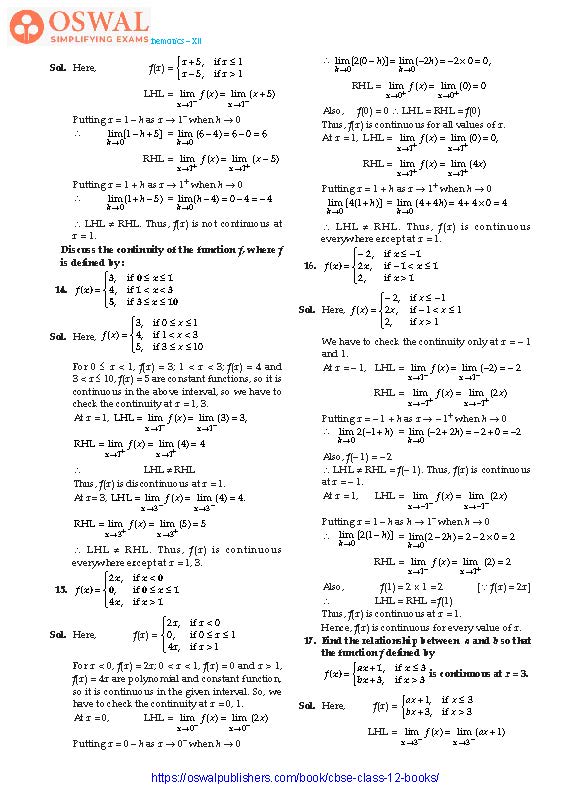
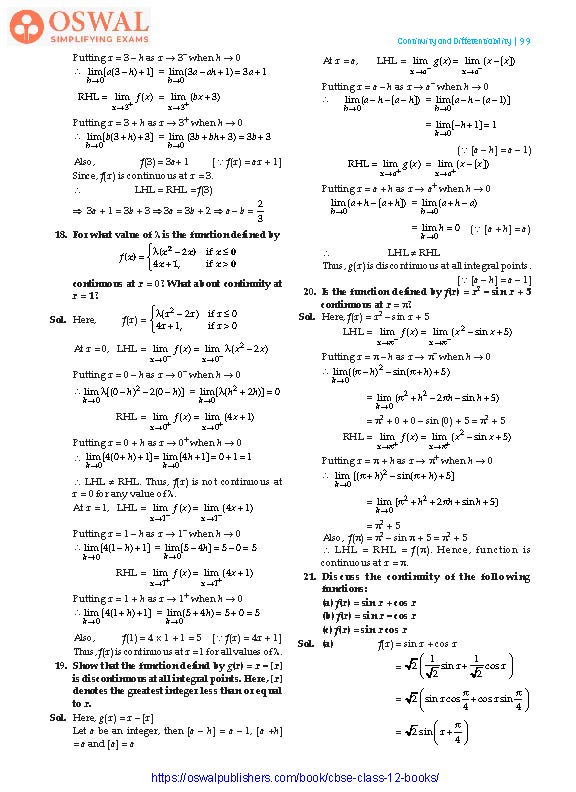
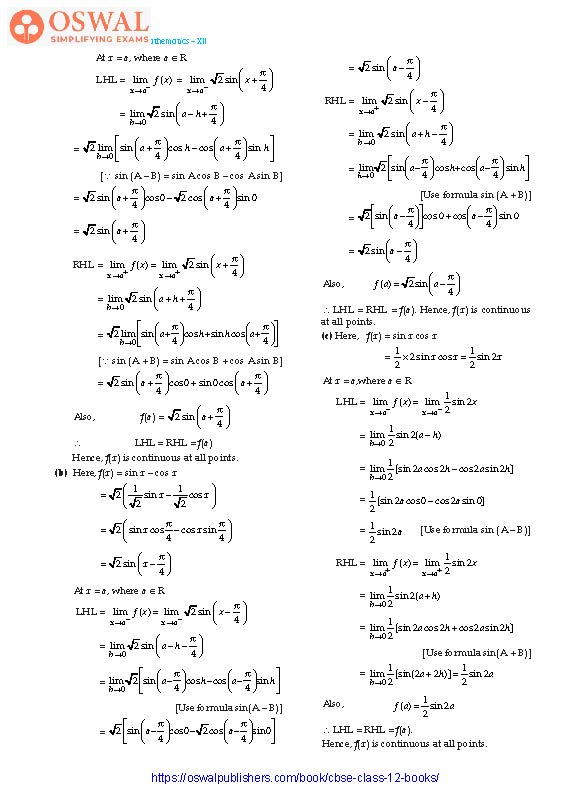
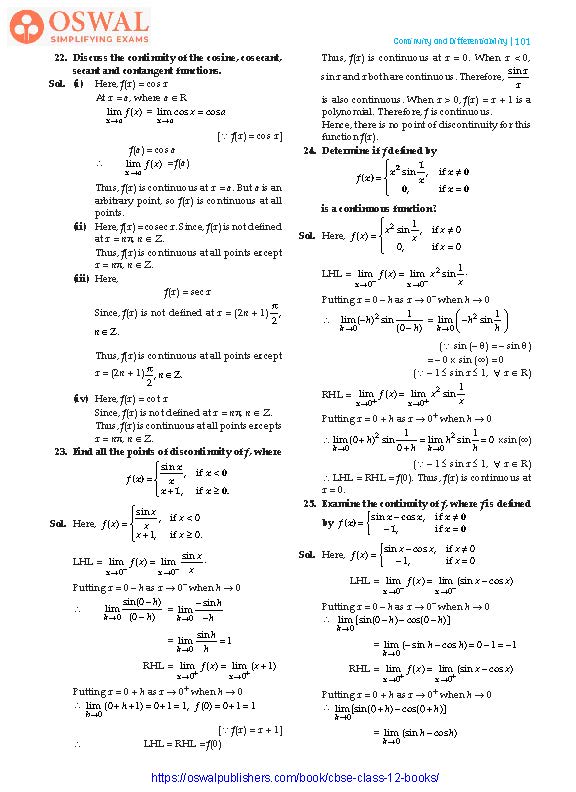
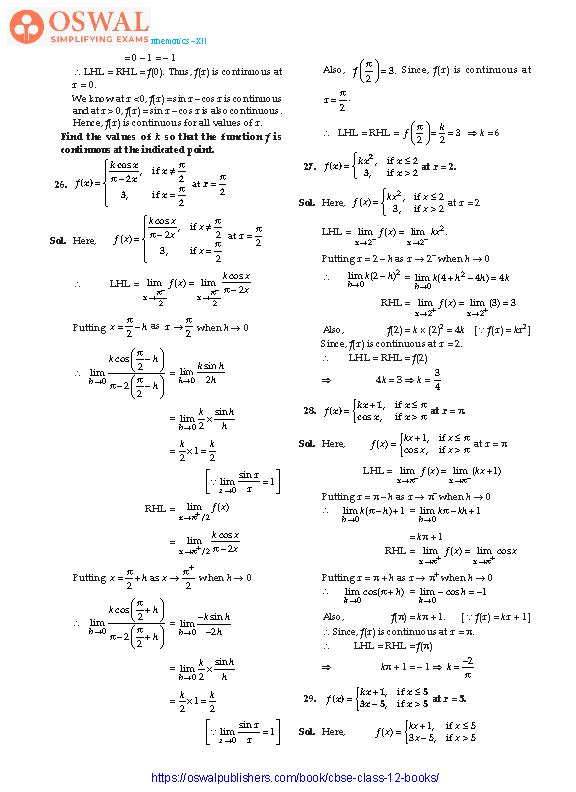
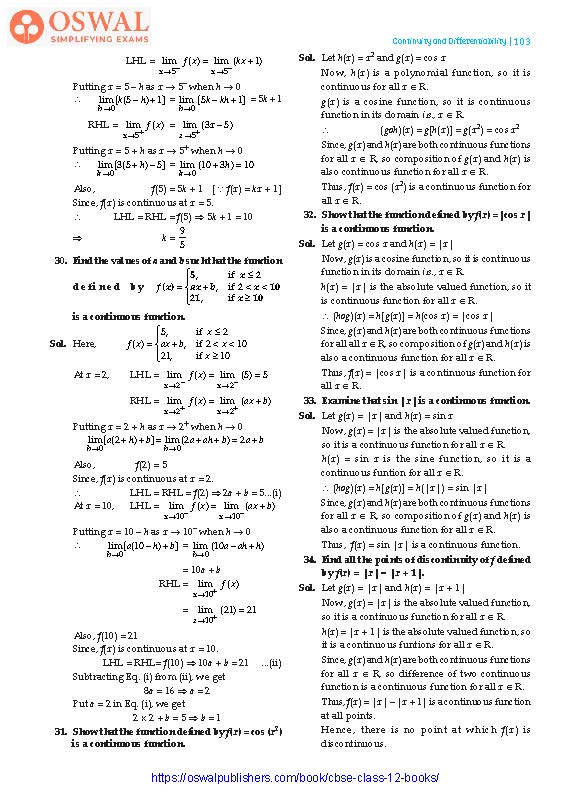
Access Exercises of Class 12 Maths Chapter 5 – Continuity and Differentiability
Exercise 5.1 Solutions: 34 Questions (Short Answers)
Exercise 5.2 Solutions: 10 Questions (Short Answers)
Exercise 5.3 Solutions: 15 Questions ( Short Answers)
Exercise 5.4 Solutions: 10 Questions (Short Answers)
Exercise 5.5 Solutions: 18 Questions ( Short Answers)
Exercise 5.6 Solutions: 11 Questions (Short Answers)
Exercise 5.7 Solutions: 17 Questions (Short Answers)
Exercise 5.8 Solutions: 6 Questions (Short Answers)
Miscellaneous Exercise Solutions: 23 Questions (6 Long, 17 Short)
Exercise 5.1
1. Prove that the function f(x) = 5x – 3 is continuous at x = 0, at x = – 3 and at x = 5.
Sol. Here, f(x) = 5x – 3
$$\text{At x = 0,}\space\lim_{x\to 0}\text{f(x)} =\\\lim_{x\to0}(5x-3) = 5×0-3$$
= 0 – 3 = – 3
f(0) = 5 × 0 – 3 = – 3
$$\therefore\space\lim_{x\to y}\space f(x) = f(0).$$
Thus, f(x) is continuous at x = 0.
At x = – 3,
$$\lim_{x\to-3}\space f(x) = \lim_{x\to-3}\space (5x-3)$$
= 5 × (– 3) – 3
= – 15 – 3 = – 18
and f(– 3) = 5 × – 3 – 3 = – 18
$$\therefore\space\lim_{x\to-3}\space f(x) = f(\normalsize-3).$$
Thus, f(x) is continuous at x = – 3.
At x = 5,
$$\lim_{x\to5}\space f(x) = \lim_{x\to5}(5x-3)\\ = 5×5-3$$
= 25 – 3 = 22
and f(5) = 5 × 5 – 3 = 25 – 3 = 22
$$\therefore\space\lim_{x\to5}\space f(x) = f(5)$$
Thus, f(x) is continuous at x = 5.
2. Examine the continuity of the function
f(x) = 2x2 – 1 at x = 3.
Sol. Here, f(x) = 2x2 – 1
$$\therefore\space\lim_{x\to3}\space f(x) = \lim_{x\to3}\space f(2x^{2}-1)$$
= 2 × (3)2 – 1 = 18 – 1 = 17
f(3) = 2 × (3)2 – 1 = 18 – 1 = 17
$$\therefore\space\lim_{x\to3}\space f(x) = f(3).$$
Thus, f(x) is continuous at x = 3.
3. Examine the following functions for continuity :
(a) f(x) = x – 5
$$\textbf{(b)\space}\textbf{f(x)\space}\textbf{=}\frac{\textbf{1}}{\textbf{x-5}}\textbf{,}\space \textbf{x}\neq\textbf{5}\\\textbf{(c)\space f(x)} = \frac{\textbf{x}^{\textbf{2}}\textbf{- 25}}{\textbf{x+5}},\textbf{x}\neq\textbf{\normalsize-5}$$
(d) f(x) = |x – 5|.
Sol. (a) f(x) = x – 5 is a polynomial function, so f(x) is continuous for all values of x.
$$\textbf{(b)\space f(x) =}\frac{1}{x-5}\space\text{is a quotient function}$$
of two polynomial functions, so f(x) is continuous for all values of x provided x ≠ 5.
$$\textbf{(c)}\space\text{f(x) = }\frac{x^{2}-25}{x+5}\\=\frac{(x+5)(x-5)}{x+5} = x-5$$
∴ f(x) = x – 5 is a polynomial function, so f(x) is continuous at all values of x.
$$\textbf{(d)\space}f(x) =|x-5|= \\\begin{cases}x-5 &\text{for x}\geq 5\\5-x&\text{for}\space x\lt 5\end{cases}$$
$$\text{For x}\xrightarrow{}5^{+},\\\lim_{x\xrightarrow{}5^{+}} =\lim_{x\xrightarrow{}5^{+}}(x-5)\\= 5-5 = 0\\\text{For}\space x\xrightarrow{}5^{\normalsize-},\\\lim_{x\xrightarrow{}5^{-}}\space f(x) = \lim_{x\to5^{-}}(5-x)\\=5-5 = 0$$
Also, f(5) = 5 – 5 = 0
∵ LHL = RHL = f(5). Therefore, the function is continuous at x = 5.
Note : If any rational function
$$f(x) =\frac{p(x)}{q(x)}\space\text{and}$$
if p(x) and q(x) are polynomials and q(x) is zero at any value of x and p(x) ≠ 0, then f(x) is not continuous at that point.
4. Prove that the function f(x) = xn is continuous at x = n, where n is a positive integer.
Sol. Here, f(x) = xn
$$\therefore\space\lim_{x\to n}\space f(x) = \lim_{x\to n}\space x^{n}=n^{n}$$
and f(n) = nn
[∵ f(x) = xn]
$$\therefore\space\lim_{x\to n}\space f(x) = f(n)$$
Thus, f(x) is continuous at x = n, where n is a positive integer.
5. Is the function f defined by
$$\textbf{f(x) = }x = \begin{cases}\textbf{x,} &\textbf{if x}\lt \textbf{1} \\\textbf{5} &\textbf{if}\space \textbf{x}\gt \textbf{1}\end{cases}$$
continuous at x = 0? At x = 1? At x = 2?
Sol. Here, f(x) =
$$\text{f(x)} =\begin{cases}\text{x}\text{,} &\text{if}\lt \text{1}\\\text{5,} &\text{if \space x}\gt\text{1}\end{cases}$$
At x = 0,
$$\text{LHL = }\lim_{x\to0^{\normalsize-}}\space\text{f(x)} =\lim_{x\to 0^{\normalsize-}}\space(x)$$
Putting x = 0 – h as x → 0– when h → 0
$$= \lim_{h\to0}(0-h) =0-0=0$$
$$\text{RHL = }\lim_{x\to0^{\normalsize-}}\space f(x) =\lim_{x\xrightarrow{}0^{+}}(x)\\\text{Putting x = 0 + h as}\\x\xrightarrow{}0^{\normalsize+}\space \text{when}\space h\xrightarrow{} 0\\=\lim_{h\xrightarrow{}0}\space (0 + h) = 0 + 0 = 0$$
Also, f(0) = 0 [∵ f(x) = x]
∴ LHL = RHL = f(0)
Thus, f(x) is continuous at x= 0.
At x = 1, LHL =
$$\lim_{x\xrightarrow{}1^{\normalsize-}}\space f(x) =\lim_{x\to 1^{\normalsize-}}(x)$$
Putting x = 1 – h as x → 1–
$$\text{when h}\xrightarrow{}0 =\lim_{h\to0}(1-h)$$
= 1 – 0 = 1
$$\text{RHL = }\lim_{x\xrightarrow{}1^{+}}\space f(x) = 5$$
∴ LHL ≠ RHL
Thus, f(x) is discontinuous at x = 1.
At x = 2,
$$\lim_{x\to 2^{\normalsize-}}\space f(x) = \lim_{x\xrightarrow{}2^{\normalsize-}}\space f(x)= 5$$
Also, f(2) = 5
∴ LHL = RHL = f(2). Thus, f(x) is continuous at x = 2.
Find all points of discontinuity of f, where f is defined in the question.
$$\textbf{6.\space f(x)} =\begin{cases}\textbf{2x+3,} &\textbf{if x}\leq \textbf{2}\\\textbf{2x-3,} &\textbf{if x}\gt \textbf{2.}\end{cases}$$
Sol. Every polynomial function is continuous. So,
the discontinuity of given function may occur at
x = 2.
$$\text{Here, f(x) = }\\\begin{cases}2x+3, &\text{if}\space x\leq2\\2x-3 &\text{if}\space x\gt 2\end{cases}\\\text{LHL =} \lim_{x\xrightarrow{}2^{-}}\space f(x) =\\\lim_{x\xrightarrow{}2^{\normalsize-}}(2x+3)$$
Putting x = 2 – h has x → 2– when h → 0
$$\therefore\space\lim_{h\to0}\lbrack2(2-h)+3\rbrack =\lim_{h\to0}(7-2h)$$
= 7 – 2 × 0 = 7
$$\text{RHL = }\lim_{x}\xrightarrow{}2^{\normalsize+}\space f(x)\\=\lim_{x\xrightarrow{}2^{+}}(2x-3)\\\text{Putting x = 2 + h as}\\x\xrightarrow{}2^{+}\space\text{when\space h}\xrightarrow{}0\\\therefore\space\lim_{h\xrightarrow{}0}\lbrack2(2+h)-3\rbrack\\=\lim_{h\to0}(1+2h) = 1+2×0=1\\\therefore\space\text{LHL}\neq\text{RHL}$$
Thus, f(x) is discontinuous at x = 2.
$$\textbf{8.\space f(x) = }\begin{cases}\frac{\textbf{|x|}}{\textbf{x}},\space \text{if x}\neq 0\\0,\space\textbf{if x}=0\end{cases}\\\textbf{Sol.\space}\text{Here}\space f(x) =\begin{cases}\frac{|x|}{x},\space \text{if x}\neq 0\\0,\space\text{if x}=0\end{cases}\\\text{LHL =}\lim_{x\to0^{\normalsize-}}\space f(x) = \lim_{x\xrightarrow{}0^{\normalsize-}}\frac{|x|}{x}$$
Putting x = 0 – h as x → 0– when h → 0
$$\therefore\space\lim_{h\to0}\frac{|0-h|}{0-h} =\lim_{h\to0}\frac{h}{\normalsize-h}=\normalsize-1\\\lbrack\because\space 1-hl =h\rbrack$$
$$\text{RHL =}\lim_{x\to 0^{+}}\space f(x) =\lim_{x\to0^{+}}\frac{|x|}{x}$$
Putting x = 0 + h as x → 0+; h → 0
$$\therefore\space\lim_{h\to0}\frac{0-h}{0+h} =\lim_{h\to0}\frac{h}{h}=1$$
∴ LHL ≠ RHL. Thus, f(x) is discontinuous at x = 0.
$$\textbf{7. f(x) =}\begin{cases}|\textbf{x}|\textbf{+ 3}\textbf{,}\space\textbf{if x}\leq\textbf{\normalsize-3}\\\textbf{\normalsize-2x}, \textbf{if}\space\normalsize\textbf{-3}\lt\textbf{x}\lt \textbf{3}\\\textbf{6x+2,\space if x}\geq \textbf{3} \end{cases}$$
Sol. Polynomial function is always continuous. So,
we have to check the continuity only at x = – 3
and 3.
$$\text{Here, f(x)} =\\\begin{cases}|x|+3, \space\text{if} x\leq\normalsize-3\\\normalsize-2x, \space\text{if}-3\lt x\lt3\\6x+2,\space\text{if}\space x\geq3\end{cases}$$
For x < – 3, f(x) = |x| + 3;
– 3 < x < 3, f(x) = – 2x and x > 3, f(x) = 6x + 2 is a polymial function, so it is continuous in a given interval. So, we have to check the continuity only at x = – 3 and 3.
At x = – 3,
$$\text{LHL = }\lim_{x\xrightarrow{}3^{\normalsize-}}\space f(x)\\=\lim_{x\xrightarrow{}3^{\normalsize-}}(|x|+3) $$
Putting x = (– 3 – h) as x → 3– when h → 0
$$\therefore\space\lim_{h\to0}\lbrack|-3-h|+3\rbrack\\=\lim_{h\to0}(6+h) =6+0=6\\\text{RHL = }\lim_{x\xrightarrow{}3^{\normalsize+}}\space f(x)=\\\lim_{x\xrightarrow{}3^{\normalsize+}}(-2x)$$
Putting x = – 3 + h as x → – 3+ when h → 0
$$\therefore\space\lim_{x\to 0}-2(-3+h) =\lim_{h\to0}(6-2h)$$
= 6 – 2 × 0 = 6
Also, f(– 3) = |– 3| + 3 = 3 + 3 = 6
[∵ f(x) = |x| + 3]
∴ LHL = RHL = f(– 3)
Thus, f(x) is continuous at x = – 3.
At x = 3,
$$\text{LHL =}\lim_{x\to3^{\normalsize-}}\space f(x) =\lim_{x\to3^{\normalsize-}}(\normalsize-2x)$$
Putting x = 3 – h as x → 3– when h → 0
$$\therefore\space\lim_{h\to0}-2(3-h) =\\\lim_{h\to0}(-6+2h)$$
= – 6 + 2 × 0 = – 6
$$\text{RHL = }\lim_{x\to 3^{+}}\space f(x) =\lim_{x\to 3^{+}}(6x+2)$$
Putting x = 3 + h as x → 3+ when h → 0
$$\therefore\space\lim_{h\to0}\lbrack-2(3-h)\rbrack =\\\lim_{h\to0}(-6+2h)$$
= – 6 + 2 × 0 = – 6
$$\text{RHL = }\lim_{h\to3^+}\space f(x) =\\\lim_{x\xrightarrow{}3^{+}}(6x+2)$$
Putting x = 3 + h as x → 3+ when h → 0
$$\therefore\space\lim_{h\to0}\lbrack6(3+h)+2\rbrack\\=\lim_{h\to0}(18+6h+2) =\lim_{h\to0}(20+6h)$$
= 20 + 6 × 0 = 20
∴ LHL ≠ RHL.
Thus, f(x) is discontinuous at x = 3.
$$\textbf{9.\space f(x) =}\begin{cases}\frac{\textbf{x}}{\textbf{|x|}}, &\textbf{if x}\lt \textbf{0}\\\textbf{\normalsize-1}\textbf{,} &\textbf{if x}\geq \textbf{0}\end{cases}$$
Sol. Here,
$$\text{f(x)} =\begin{cases}\frac{x}{|x|},\space\text{if x}\lt 0\\\normalsize-1, \text{if x}\geq0\end{cases}\\\text{LHL = }\lim_{x\to0^{\normalsize-}}\space f(x) \\=\lim_{x\to0^{\normalsize-}}\frac{x}{|x|}$$
Putting x = 0 – h as x → 0–, when h → 0
$$\therefore\space\lim_{h\to0}\frac{0-h}{|0-h|} =\lim_{h\to0}\frac{\normalsize-h}{h}=\normalsize-1$$
(∵ |– h| = h)
$$\text{RHL =}\space\lim_{x\to0^{\normalsize+}}\space f(x)=-1$$
Also, f(0) = – 1
∴ LHL = RHL = f(0)
Thus, f(x) is continuous at x = 0. There is no point of discontinuity for the function f(x).
$$\textbf{10.\space f(x) =}\begin{cases}\textbf{x+1,} \space\textbf{if x}\geq\textbf{1}\\\textbf{x}^{\textbf{2}}\textbf{+1}\textbf{,}\space \textbf{if x}\lt1\end{cases}\\\textbf{Sol.\space} \text{Here,}\\\text{\space f(x)} = \begin{cases}x+1,\space \text{if x}\geq1\\x^{2}+1,\space\text{if x}\lt 1\end{cases}$$
For x > 1, f(x) = x + 1 and x < 1, f(x) = x2 + 1 is a polynomial function, so f(x) is continuous in the given interval. Therefore, we have to check the continuity at x = 1.
$$\text{LHL = }\lim_{x\xrightarrow{}1^{\normalsize-}}\space f(x) =\lim_{x\to1^{\normalsize-}}(x^{2}+1)$$
Putting x = 1 – h as x → 1– when h → 0
$$\therefore\space\lim_{h\to0}\lbrack(1-h)^{2}+1\rbrack =\\\lim_{h\to0}\lbrack1+h^{2}-2h+1\rbrack\\=\lim_{h\to0}\lbrack2 + h^{2}-2h\rbrack$$
= 2 + 0 – 0 = 2
$$\text{RHL = }\lim_{x\to 1^{\normalsize+}}\space f(x)=\\\lim_{x\to1^{\normalsize+}}(x+1)$$
Putting x = 1 + h as x → 1+ when h → 0
$$\therefore\space\lim_{h\to0}(1 +h+1) =\lim_{h\to0}(2+h)\\=2+0=2$$
Also f(1) = 1 + 1 = 2
[∵ f(x) = x + 1]
∴ LHL = RHL = f(1). Thus, f(x) is continuous at x = 1.
Hence, there is no point of discontinuity for this function f(x).
$$\textbf{11. f(x) =}\begin{cases}\textbf{x}^{\textbf{3}}\textbf{-3}\textbf{,} &\textbf{if} \textbf{x}\leq\textbf{2}\\\textbf{x}^{\textbf{2}}\textbf{+ 1}\textbf{,} &\textbf{if x}\gt \textbf{2.}\end{cases}$$
Sol. Here,
$$\text{f(x) = }\begin{cases}x^{3}-3 &\text{if\space x}\leq2\\x^{2}+1, &\text{if\space x}\gt2.\end{cases}$$
For x < 2, f(x) = x3 – 3 and for x > 2, f(x) = x2 + 1 is a polynomial function, so f is continuous in the above interval. Therefore, we have to check the continuity at x = 2.
$$\text{LHL = }\lim_{x\to2^{\normalsize-}}\space f(x) =\lim_{x\xrightarrow{}2^{\normalsize -}}(x^{3}-3)$$
Putting x = 2 – h as x → 2– when h → 0
$$\therefore\space\lim_{h\to0}\lbrack(2-h)^{3}-3\rbrack\\=\lim_{h\to0}\lbrack 8-h^{3}-12h+6h^{2}-3\rbrack\\=\lim_{h\to0}(5-h^{3}-12h+6h^{2}) = 5\\\text{RHL =}\lim_{x\xrightarrow{}2^{\normalsize+}\space}f(x) =\\\lim_{x\xrightarrow{}2^{\normalsize+}}(x^{2}+1)$$
Putting x = 2 + h as x → 2+ when h → 0
$$\therefore\space\lim_{h\to0}\lbrack(2+h)^{2}+1\rbrack\\=\lim_{h\to0}(4+h^{2}+4h+1)\\=\lim_{h\to0}(5+h^{2}+4h) =5$$
Also, f(2) = (2)3 – 3 = 8 – 3 = 5
[∵ f(x) = x3 – 3]
∴ LHL = RHL = f(2). Thus, f(x) is continuous at x = 2.
Hence, there is no point of discontinuity for this function f(x).
$$\textbf{12\space f(x) =}\begin{cases}\textbf{x}^{\textbf{10}}\textbf{- 1,} &\textbf{if x}\leq\textbf{1}\\\textbf{x}^{\textbf{2}},&\textbf{if x}\gt\textbf{1.}\end{cases}\\\textbf{Sol.\space}\text{Here,} \\\text{f(x)} = \begin{cases}x^{10}-1,\space\text{if}\leq 1\\x^{2},\space\text{if\space} x\gt1.\end{cases}$$
For x < 1, f(x) = x10 – 1 and x > 1, f(x) = x2 is a polynomial function, so f is continuous in the above interval. Therefore, we have to check the continuity at x = 1.
$$\text{LHL =\space}\lim_{x\xrightarrow{}1^{\normalsize-}}\space f(x) =\\\lim_{x\xrightarrow{}1^{\normalsize-}}(x^{10}-1)$$
Putting x = 1 – h as x → 1– when h → 0
$$\therefore\space\lim_{h\to0}\lbrack(1-h)^{10}-1\rbrack$$
= (1 – 0)10 – 1 = 1 – 1 = 0
$$\text{RHL = }\lim_{x\xrightarrow{}1^{\normalsize+}}\space f(x) =\lim_{x\xrightarrow{}1^{+}}(x^{2})$$
Putting x = 1 + h as x → 1+ when h → 0
$$\therefore\space\lim_{h\to0}(1+h)^{2} =\lim_{h\to0}(1 +h^{2}+2h)=1$$
∴ LHL ≠ RHL
Thus, f(x) is discontinuous at x = 1.
13. Is the function defined by
$$\textbf{f(x) = }\begin{cases}\textbf{x+5},\space\textbf{if x}\leq \textbf{1}\\\textbf{x-5},\space \textbf{if x}\geq \textbf{1}\textbf{,}\end{cases}$$
a continuous function?
$$\textbf{Sol.\space} \text{Here,}\\\space f(x) =\begin{cases}x+5, &\text{if x}\leq 1\\x-5, &\text{if x}\gt1\end{cases}\\\text{LHL = }\lim_{x\xrightarrow{}1^{\normalsize-}} f(x)=\lim_{x\xrightarrow{}1^{\normalsize-}}(x+5)$$
Putting x = 1 – h as x → 1– when h → 0
$$\therefore\space\lim_{h\to0}\lbrack1-h+5\rbrack =\lim_{h\to0}(6-4) \\=6-0 =6\\\text{RHL =}\lim_{x\to1^{+}\space}f(x) =\lim_{x\to1^{\normalsize+}}(x-5)$$
Putting x = 1 + h as x → 1+ when h → 0
$$\therefore\space\lim_{h\to0}(1 + h-5) =\lim_{h\to0}(h-4)\\= 0-4=-4$$
∴ LHL ≠ RHL.
Thus, f(x) is not continuous at x = 1.
Discuss the continuity of the function f, where f is defined by :
$$\textbf{14.\space f(x) =}\begin{cases}\textbf{3}\textbf{,}\space\textbf{if 0}\leq\textbf{x}\leq \textbf{1 }\\\textbf{4}\textbf{,}\space\textbf{if 1}\lt \textbf{x}\lt \textbf{3}\\\textbf{5}\textbf{,}\space \textbf{if 3}\leq\textbf{x} \leq\textbf{10}\end{cases}\\\textbf{Sol.\space}\text{Here, f(x)} = \\\begin{cases}3,\space\text{if 0}\leq x\leq1\\4,\space\text{if}\space1\lt x\lt 3\\5,\space\text{if}\space 3\leq x\leq10\end{cases}$$
For 0 ≤ x < 1, f(x) = 3; 1 < x < 3; f(x) = 4 and 3 < x ≤ 10, f(x) = 5 are constant functions, so it is continuous in the above interval, so we have to check the continuity at x = 1, 3.
At x = 1,
$$\text{LHL = }\lim_{x\xrightarrow{}1^{\normalsize-}}\space f(x)\\=\lim_{x\xrightarrow{}1^{\normalsize-}}(3) = 3,$$
$$\text{RHL =}\lim_{x\xrightarrow{}1^{\normalsize+}}f(x) =\lim_{x\xrightarrow{}1^{+}}(4) = 4$$
∴ LHL ≠ RHL
Thus, f(x) is discontinuous at x = 1.
At x= 3, LHL =
$$\lim_{x\xrightarrow{}3^{\normalsize-}}\space f(x) =\lim_{x\xrightarrow{}3^{\normalsize-}}(4)=4.$$
$$\text{RHL = }\lim_{x\xrightarrow{}3^{\normalsize+}}f(x) \\=\lim_{x\xrightarrow{}3^{\normalsize-}}(4)= 4.$$
∴ LHL ≠ RHL. Thus, f(x) is continuous everywhere except at x = 1, 3.
$$\textbf{15.\space f(x) =}\begin{cases}\textbf{2x,} \space\textbf{if x}\lt\textbf{0}\\\textbf{0} \space\textbf{if}\space 0\leq\textbf{x}\leq\textbf{1}\\\textbf{4x ,}\space\textbf{if x}\gt 1\end{cases}\\\textbf{Sol.\space}\text{Here,\space f(x) =}\begin{cases}2x\space\text{if}x\lt 0\\0 \space\text{if 0}\leq x\leq 1\\4x,\space\text{if x}\gt1\end{cases}$$
For x < 0, f(x) = 2x; 0 < x < 1, f(x) = 0 and x > 1, f(x) = 4x are polynomial and constant function, so it is continuous in the given interval. So, we have to check the continuity at x = 0, 1.
At x = 0,
$$\text{LHL = }\lim_{x\xrightarrow{}0^{\normalsize-}}\space f(x) =\lim_{x\xrightarrow{}0^{\normalsize-}}(2x)$$
Putting x = 0 – h as x → 0– when h → 0
$$\therefore\space\lim_{h\to0}\lbrack2(0-h)\rbrack =\lim_{h\to0}(\normalsize-2h)$$
= -2×0 = 0,
$$\text{RHL = }\lim_{x\to0^{\normalsize+}}f(x) =\lim_{x\xrightarrow{}0^{\normalsize+}}(0) = 0$$
Also, f(0) = 0 ∴ LHL = RHL = f(0)
Thus, f(x) is continuous for all values of x.
At x = 1,
$$\text{LHL =}\lim_{x\xrightarrow{}1^{\normalsize+}}f(x) =\lim_{x\xrightarrow{}1^{+}}(0) =0,\\\text{RHL =}\lim_{x\xrightarrow{}1^{\normalsize+}}f(x) =\lim_{x\xrightarrow{}1^{\normalsize+}}(4x)$$
Putting x = 1 + h as x → 1+ when h → 0
$$\lim_{h\to0}\lbrack4(1+h)\rbrack =\lim_{h\to0}(4+4h)$$
= 4+4×0
∴ LHL ≠ RHL. Thus, f(x) is continuous everywhere except at x = 1.
$$\textbf{16.\space f(x) =}\begin{cases}\textbf{-2},\space \textbf{if \space x}\leq \textbf{\normalsize-1}\\\textbf{2x,\space}\textbf{if \normalsize-1}\lt \textbf{x}\leq\textbf{1}\\\textbf{2,}\space\textbf{if x}\gt \textbf{1}\end{cases}\\\textbf{Sol.\space}\text{Here, f(x) =}\begin{cases}\normalsize-2, \space\text{if x}\leq\normalsize-1\\2x \space\text{if \normalsize-1}\lt x\leq1\\2,\space\text{if x}\gt 1\end{cases}$$
We have to check the continuity only at x = – 1 and 1.
At x = – 1,
$$\text{LHL =}\lim_{x\xrightarrow{}1^{\normalsize-}}\space f(x) \\=\lim_{x\xrightarrow{}1^{\normalsize-}}(\normalsize-2)=-2\\\text{RHL =}\lim_{x\xrightarrow{}1^{\normalsize+}}f(x) =\lim_{x\xrightarrow{}1^{\normalsize+}}(2x) $$
Putting x = – 1 + h as x → – 1+ when h → 0
$$\therefore\space\lim_{h\to0}\space 2(\normalsize-1+h) =\lim_{h\to0}(-2+2h)\\=-2+0=\normalsize-2$$
Also, f(– 1) = – 2
∴ LHL ≠ RHL = f(– 1). Thus, f(x) is continuous at x = – 1.
At x = 1,
$$\text{LHL =}\lim_{x\xrightarrow{}1^{\normalsize-}}f(x)=\lim_{x\xrightarrow{}1^{\normalsize-}}(2x)$$
Putting x = 1 – h as h → 1– when h → 0
$$\therefore\space\lim_{h\to0}\lbrack2(1-h)\rbrack =\lim_{h\to0}(2-2h)\\= 2-2×0 =2\\\text{RHL =}\lim_{x\xrightarrow{}1^{\normalsize-}} f(x)\\=\lim_{x\xrightarrow{}1^{\normalsize+}}(2)=2$$
Also, f(1) = 2 × 1 = 2
[∵ f(x) = 2x]
∴ LHL = RHL = f(1)
Thus, f(x) is continuous at x = 1.
Hence, f(x) is continuous for every value of x.
17. Find the relationship between a and b so that the function f defined by
$$\textbf{f(x) =}\begin{cases}\textbf{ax+1}, &\textbf{if x}\leq \textbf{3}\\\textbf{bx+3}&\textbf{if x}\gt\textbf{3}\end{cases}$$
is continuous at x = 3.
Sol. Here,
$$f(x) =\begin{cases}ax+1, &\text{if x}\leq 3\\bx+3, &\text{if x}\gt 3\end{cases}\\\text{LHL = }\lim_{x\xrightarrow{}3^{\normalsize-}}\space f(x)=\\\lim_{x\xrightarrow{}3^{\normalsize-}}(ax+1)$$
Putting x = 3 – h as x → 3– when h → 0
$$\therefore\space\lim_{h\to0}\lbrack a(3-h)+1\rbrack=\\\lim_{h\to0}(3a-ah+1)=3a+1\\\text{RHL =}\lim_{x\xrightarrow{}3^{\normalsize+}\space}f(x) =\lim_{x\xrightarrow{}3^{\normalsize+}}(bx+3)$$
Putting x = 3 + h as x → 3+ when h → 0
$$\therefore\space\lim_{h\to0}\lbrack b(3+h) +3 \rbrack\\=\lim_{h\to0}(3b+bh+3) = 3b+3$$
Also, f(3) = 3a+ 1 [∵ f(x) = ax + 1]
Since, f(x) is continuous at x = 3.
∴ LHL = RHL = f(3)
⇒ 3a + 1 = 3b + 3 ⇒ 3a = 3b + 2
$$\Rarr\space a-b = \frac{2}{3}$$
18. For what value of l is the function defined by
$$\textbf{f(x) =}\begin{cases}\lambda(\textbf{x}^{\textbf{2}}\textbf{- 2x})\space \textbf{if x}\leq\textbf{0}\\\textbf{4x+1},\space \textbf{if x}\gt \textbf{0}\end{cases}$$
continuous at x = 0? What about continuity at x = 1?
Sol. Here,
$$f(x) =\begin{cases}\lambda(x^{2}-2x)\space\text{if x}\leq0\\4x+1,\space \text{if x}\gt0\end{cases}$$
At x = 0,
$$\text{LHL = }\lim_{x\to0^{\normalsize-}}\space f(x) =\\\lim_{x\to 0^{\normalsize-}}\lambda(x^{2}-2x)$$
Putting x = 0 – h as x → 0– when h → 0
$$\therefore\space\lim_{h\to0}\space\lambda\lbrack(0-h)^{2}-2(0-h)\rbrack\\=\lim_{h\to0}\lbrack\lambda(h^{2}+2h)\rbrack =0\\\text{RHL =}\lim_{x\to0^{+}}\space f(x) \\=\lim_{x\to0^{+}}(4x+1)$$
Putting x = 0 + h as x → 0+ when h → 0
$$\therefore\space\lim_{h\to0}\lambda\lbrack(0-h)^{2}-2(0-h)\rbrack =\\\lim_{h\to0}\lbrack\lambda(h^{2}+2h)\rbrack = 0\\\text{RHL =}\lim_{x\to0^{\normalsize +}}\space f(x) = \lim_{x\to0^{\normalsize+}}(4x+1)$$
Putting x = 0 + h as x → 0+ when h → 0
$$\therefore\space\lim_{h\to 0}\lbrack4(0+h)+1\rbrack\\=\lim_{h\to0}\lbrack4h+1\rbrack\\=0+1=1$$
∴ LHL ≠ RHL. Thus, f(x) is not continuous at x = 0 for any value of λ.
At x = 1,
$$\text{LHL = }\lim_{x\xrightarrow{}1^{\normalsize-}}f(x) \\=\lim_{x\xrightarrow{}1^{\normalsize-}}(4x+1)$$
Putting x = 1 – h as x → 1– when h → 0
$$\therefore\space\lim_{h\to0}\lbrack4(1-h)+1\rbrack\\=\lim_{h\to0}\lbrack5-4h\rbrack\\=5-0=5$$
$$\text{RHL =}\lim_{x\to1^{\normalsize+}}\space f(x) =\\\lim_{x\to1^{\normalsize+}}(4x+1)$$
Putting x = 1 + h as x → 1+ when h → 0
$$\therefore\space\lim_{h\to0}\lbrack4+(1+h)+1\rbrack\\=\lim_{h\to0}(5+4h)\\= 5+0 =5$$
Also, f(1) = 4 × 1 + 1 = 5
[∵ f(x) = 4x + 1]
Thus, f(x) is continuous at x = 1 for all values of λ.
19. Show that the function defind by g(x) = x – [x] is discontinuous at all integral points. Here, [x] denotes the greatest integer less than or equal to x.
Sol. Here, g(x) = x – [x]
Let a be an integer, then [a – h] = a – 1, [a +h]
= a and [a] = a
At x = a,
$$\text{LHL = }\lim_{x\xrightarrow{}a^{\normalsize-}}g(x) =\\\lim_{x\xrightarrow{}a^{\normalsize-}}(x-[x])$$
Putting x = a – h as x → a– when h → 0
$$\therefore\space\lim_{h\to0}(a-h-[a-h]) =\\\lim_{h\to0}\lbrack a-h-(a-1)\rbrack\\=\lim_{h\to0}\lbrack-h+1\rbrack = 1$$
(∵ [a – h] = a – 1)
$$\text{RHL =}\lim_{x\to a^{\normalsize+}}g(x) =\\\lim_{x\to a^{+}}(x-\lbrack x\rbrack)$$
Putting x = a + h as x → a+ when h → 0
$$\lim_{a\to0}(a+h -\lbrack a+h\rbrack)=\\\lim_{h\to0}(a+h-a)\\=\lim_{h\to0}h =0$$
(∵ [a + h] = a)
LHL ≠ RHL
Thus, g(x) is discontinuous at all integral points.
[∵ [a – h] = a – 1]
20. Is the function defined by f(x) = x2 – sin x + 5 continuous at x = π?
Sol. Here, f(x) = x2 – sin x + 5
LHL =
$$\lim_{x\to\pi^{\normalsize-}}\space f(x) =\\\lim_{x\rightarrow{}\pi^{\normalsize-}}(x^{2}-sin x +5)$$
Putting x = π – h as x → π– when h → 0
$$\therefore\space\lim_{h\to0}((\pi-h^{2}) - \text{sin}(\pi+h)+5)\\=\lim_{h\to0}\space(\pi^{2}+h^{2}-2\pi h -\text{sin h}+5)\\=\pi^{2}+0+0-\text{sin}(0)+5$$
= π2 + 5
$$\text{RHL\space =}\lim_{x\xrightarrow{}\pi^{\normalsize+}}\space f(x)=\\\lim_{x\xrightarrow{}\pi^{\normalsize+}}(x^{2}-\text{sin x+5})$$
Putting x = π + h as x → π+ when h → 0
$$\therefore\space\lim_{h\to0}\lbrack(\pi+h)^{2} -\text{sin}(\pi+h)+5\rbrack\\=\lim_{h\to0}\lbrack\pi^{2} + h^{2} +2\pi h +sin h +5\rbrack\\=\pi^{2}+5$$
Also, f(π) = π2 – sin π + 5 = π2 + 5
∴ LHL = RHL = f(π).
Hence, function is continuous at x = π.
21. Discuss the continuity of the following
functions:
(a) f(x) = sin x + cos x
(b) f(x) = sin x – cos x
(c) f(x) = sin x cos x
Sol. (a) f(x) = sin x + cos x
$$= \sqrt{2}\bigg(\frac{1}{\sqrt{2}}\text{sin x} + \frac{1}{\sqrt{2}}\text{cos x}\bigg)\\=\sqrt{2}\bigg(\text{sin x cos}\frac{\pi}{4} + \text{cos x sin}\frac{\pi}{4}\bigg)\\=\sqrt{2}\text{sin}\bigg(x+\frac{\pi}{4}\bigg)$$
At x = a, where a ∈ R
$$\text{LHL = }\lim_{x\xrightarrow{}a^{\normalsize-}}\space f(x) =\\\lim_{x\xrightarrow{}a^{\normalsize-}}\space\sqrt{2}\space\text{sin}\bigg(x + \frac{\pi}{4}\bigg)\\=\lim_{h\to0}\sqrt{2}\text{sin}\bigg(a -h+\frac{\pi}{4}\bigg)$$
$$=\sqrt{2}\lim_{h\to0}\bigg[\text{sin}\bigg(a + \frac{\pi}{4}\bigg)\text{cos h -}\\\text{cos}\bigg(a + \frac{\pi}{4}\bigg)\text{sin h}\bigg]$$
[∵ sin (A – B) = sin A cos B – cos A sin B]
$$= \sqrt{2}\text{sin}\bigg(a +\frac{\pi}{4}\bigg)\text{cos 0} -\\\sqrt{2}\text{cos}\bigg(a + \frac{\pi}{4}\bigg)\text{sin 0}\\=\sqrt{2}\space\text{sin}\bigg(a + \frac{\pi}{4}\bigg)$$
$$\text{RHL = }\space\lim_{x\xrightarrow{}a^{\normalsize+}}f(x)\\=\lim_{x\xrightarrow{}a^{\normalsize+}}\space\sqrt{2}sin\bigg(x + \frac{\pi}{4}\bigg)\\=\lim_{h\to0}\sqrt{2} sin\bigg(a + h+\frac{\pi}{4}\bigg)\\=\sqrt{2}\lim_{h\to0}\bigg[\text{sin}\bigg(a + \frac{\pi}{4}\bigg)\text{cos h}+\\\text{sinh cos}\bigg(a + \frac{\pi}{4}\bigg)\bigg]$$
[∵ sin (A + B) = sin A cos B + cos A sin B]
$$=\sqrt{2}\text{sin}\bigg(a + \frac{\pi}{4}\bigg)\text{cos 0} +\\\text{sin o cos}\bigg(a + \frac{\pi}{4}\bigg)\\\text{Also,\space f(a)} =\sqrt{2}\text{sin}\bigg(a + \frac{\pi}{4}\bigg)$$
∴ LHL = RHL = f(a)
Hence, f(x) is continuous at all points.
(b) Here, f(x) = sin x – cos x
$$= \sqrt{2}\bigg(\frac{1}{\sqrt{2}}\text{sin x} -\frac{1}{\sqrt{2}}\text{cos x}\bigg)\\=\sqrt{2}\bigg(\text{sin xcos}\frac{\pi}{4} -\text{cos x sin}\frac{\pi}{4}\bigg)\\=\sqrt{2}\space\text{sin}\bigg(x-\frac{\pi}{4}\bigg)$$
At x = a, where a ∈ R
$$\text{LHL =}\space\lim_{x\to a^{\normalsize-}}\space f(x) =\\\lim_{x\xrightarrow{}a^{\normalsize-}}\space\sqrt{2}\space\text{sin}\bigg(x -\frac{\pi}{4}\bigg)\\=\lim_{h\to0}\space \sqrt{2}\text{sin}\bigg(a-h-\frac{\pi}{4}\bigg)\\=\lim_{h\to0}\sqrt{2}\\\bigg[\text{sin}\bigg(a -\frac{\pi}{4}\bigg)\text{cos h -}\\ \text{cos}\bigg(a -\frac{\pi}{4}\bigg)\text{sin h}\bigg]$$
[Use formula sin(A – B)]
$$=\sqrt{2}\begin{bmatrix}\text{sin}\bigg(a -\frac{\pi}{4}\bigg)\text{cos 0 -}\\\sqrt{2}\text{cos}\bigg(a -\frac{\pi}{4}\bigg)\text{sin 0}\end{bmatrix}\\=\sqrt{2}\text{sin}\bigg(a -\frac{\pi}{4}\bigg)\\\text{RHL = }\lim_{x\xrightarrow{}a^{\normalsize+}}\space\sqrt{2}\text{sin}\bigg(x -\frac{\pi}{4}\bigg)\\=\lim_{h\to0}\space\sqrt{2}\text{sin}\bigg(a + h-\frac{\pi}{4}\bigg)\\=\lim_{h\to0}\sqrt{2}\begin{bmatrix}\text{sin}\bigg(a -\frac{\pi}{4}\bigg)\text{cos h +}\\\text{cos}\bigg(a -\frac{\pi}{4}\bigg)\text{sin h}\end{bmatrix}$$
[Use formula sin (A + B)]
$$=\sqrt{2}\begin{bmatrix}\text{sin}\bigg(a -\frac{\pi}{4}\bigg)\end{bmatrix}\text{cos 0 +}\\\text{cos}\bigg(a -\frac{\pi}{4}\bigg)\text{sin 0}\\=\sqrt{2}\text{sin}\bigg(a -\frac{\pi}{4}\bigg)\\\text{Also,\space f(a) =}\sqrt{2}\text{sin}\bigg(a - \frac{\pi}{4}\bigg)$$
∴ LHL = RHL = f(a). Hence, f(x) is continuous at all points.
(c) Here, f(x) = sin x cos x
$$=\frac{1}{2}×2\text{sin x cos x}\\=\frac{1}{2}\text{sin 2x}$$
At x = a,where a ∈ R
$$\text{LHL =}\lim_{x\xrightarrow{}a^{\normalsize-}}\space f(x) =\\\lim_{x\xrightarrow{}a^{\normalsize-}}\frac{1}{2}\text{sin 2x}\\=\lim_{h\to0}\frac{1}{2}\text{sin}\space2(a-b)\\=\lim_{h\to0}\frac{1}{2}\lbrack\text{sin 2a cos 2h - cos 2a sin 2h}\rbrack\\=\frac{1}{2}\lbrack\text{sin 2a cos 0 - cos 2a sin0}\rbrack\\=\frac{1}{2}\text{sin 2a}$$
[Use formula sin (A – B)]
$$\text{RHL = }\lim_{x\xrightarrow{}a^{\normalsize+}}f(x) =\\\lim_{x\xrightarrow{}a^{\normalsize+}}\frac{1}{2}\text{sin 2x}\\=\lim_{h\to0}\frac{1}{2}\text{sin}2(a+h)\\ =\lim_{h\to0}\frac{1}{2}\lbrack\text{sin 2a cos 2h +cos 2a sin 2h}\rbrack$$
[Use formula sin(A + B)]
$$=\lim_{h\to0}\frac{1}{2}\lbrack\text{sin}(2a + 2h)\rbrack\\=\frac{1}{2}\text{sin 2a}\\\text{Also,\space f(a) =}\frac{1}{2}\text{sin 2a}$$
∴ LHL = RHL = f(a).
Hence, f(x) is continuous at all points.
22. Discuss the continuity of the cosine, cosecant, secant and contangent functions.
Sol. (i) Here, f(x) = cos x
At x = a, where a ∈ R
$$\lim_{x\xrightarrow{}a}\space f(x) =\\\lim_{x\to a}\space\text{cos x = cos a}$$
[∵ f(x) = cos x]
f(a) = cos a
$$\therefore\space\lim_{x\xrightarrow{}a}f(x) = f(a)$$
Thus, f(x) is continuous at x = a. But a is an
arbitrary point, so f(x) is continuous at all
points.
(ii) Here, f(x) = cosec x. Since, f(x) is not defined
at x = nπ, n ∈ Z.
Thus, f(x) is continuous at all points except x = nπ, n ∈ Z.
(iii) Here,
f(x) = sec x
Since, f(x) is not defined at
$$x =(2n+1)\frac{\pi}{2},n\epsilon Z.$$
Thus, f(x) is continuous at all points except
$$x = (2n+1)\frac{\pi}{2},n\epsilon Z.$$
(iv) Here, f(x) = cot x
Since, f(x) is not defined at x = nπ, n ∈ Z.
Thus, f(x) is continuous at all points excepts x = nπ, n ∈ Z.
23. Find all the points of discontinuity of f, where
$$\textbf{f(x) = }\begin{cases}\frac{\textbf{sin x}}{\textbf{x}} &\textbf{if x}\lt \textbf{0}\\\textbf{x+1} &\textbf{if x}\geq\textbf{0.}\end{cases}\\\textbf{Sol.}\space\text{Here,}\\\space f(x) =\begin{cases}\frac{\text{sin x}}{x}, &\text{if x}\lt 0\\x+1 &\text{if} x\geq0.\end{cases}\\\text{LHL = }\lim_{x\xrightarrow{}0^{\normalsize-}}\space f(x) =\\\lim_{x\xrightarrow{}0^{\normalsize-}}\frac{\text{sin x}}{x}.$$
Putting x = 0 – h as x → 0– when h → 0
$$\therefore\space\lim_{h\to0}\frac{\text{sin}(0-h)}{(0-h)}\\=\lim_{h\to0}\frac{-\text{sin h}}{\normalsize-h}\\=\lim_{h\to0}\frac{sin h}{h}=1\\\text{RHL =}\lim_{x\xrightarrow{}0^{\normalsize+}}f(x) =\\\lim_{x\xrightarrow{}0^{\normalsize+}}(x+1)$$
Putting x = 0 + h as x → 0+ when h → 0
$$\therefore\space\lim_{h\to0}(0+h+1) = 0+1=1,$$
f(0) = 0+1 = 1
[∵ f(x) = x + 1]
∴ LHL = RHL = f(0)
Thus, f(x) is continuous at x = 0. When x < 0, sin x and x both are continuous.
$$\text{Therefore,}\frac{\text{sin x}}{x}\space\text{is also continuous.}$$
When x > 0, f(x) = x + 1 is a polynomial. Therefore, f is continuous.
Hence, there is no point of discontinuity for this function f(x).
24. Determine if f defined by
$$\textbf{f(x) =}\space\begin{cases}\textbf{x}^{\textbf{2}}\textbf{sin}\frac{\textbf{1}}{\textbf{x}}\textbf{,}\space\textbf{if x}\neq \textbf{0}\\\textbf{0,}\space \textbf{if x = 0}\end{cases}$$
is a continuous function?
Sol. Here,
$$f(x) =\begin{cases}x^{2}\text{sin}\frac{1}{x},\space\text{if x}\neq 0\\0,\space if x = 0\end{cases}\\\text{LHL = }\lim_{x\xrightarrow{}0^{\normalsize-}}\space f(x) =\\\lim_{x\xrightarrow{}0^{\normalsize-}}\space x^{2}\text{sin}\frac{1}{x}.$$
Putting x = 0 – h as x → 0– when h → 0
$$\therefore\space\lim_{h\to0}(-h^{2})\text{sin}\frac{1}{(0-h)}=\\\lim_{h\to0}\bigg(-h^{2}\text{sin}\frac{1}{h}\bigg)$$
(∵ sin (– θ) = – sin θ)
= – 0 × sin (∞) = 0
(∵ – 1 ≤ sin x ≤ 1, ∀ x ∈ R)
$$\text{RHL = }\lim_{x\xrightarrow{}0^{\normalsize+}}\space f(x) =\\\lim_{x\to0^{\normalsize+}}\space x^{2}\text{sin}\frac{1}{x}$$
Putting x = 0 + h as x → 0+ when h → 0
$$\therefore\space\lim_{h\to 0}(0+h)^{2}\text{sin}\frac{1}{0+h}=\\\lim_{h\to0}\space h^{2}\text{sin}\frac{1}{h} = 0×\text{sin}(\infty)$$
(∵ – 1 ≤ sin x ≤ 1, ∀ x ∈ R)
∴ LHL = RHL = f(0).
Thus, f(x) is continuous at x = 0.
25. Examine the continuity of f, where f is defined by
$$\textbf{f(x) =}\begin{cases}\textbf{sin x - cos x,}\space\textbf{if x}\neq\textbf{0}\\\normalsize-1,\space\textbf{if x =0}\end{cases}$$
Sol. Here,
$$f(x) =\begin{cases}\text{sin x-cos x}\space\text{if x}\neq 0\\\normalsize-1,\space\text{if x}=0\end{cases}\\\text{LHL =}\lim_{x\xrightarrow{}0^{\normalsize-}}\space f(x)=\\\lim_{x\xrightarrow{}0^{\normalsize-}}\space(\text{sin x - cos x})$$
Putting x = 0 – h as x → 0– when h → 0
$$\therefore\space\lim_{h\to0}\lbrack\text{sin}(0-h) -\text{cos}(0-h)\rbrack\\=\lim_{h\to0}\space(-\text{sin h} - \text{cos h})\\=0-1=\normalsize-1\\\text{RHL =}\lim_{x\xrightarrow{}0^{\normalsize+}}\space f(x) =\\\lim_{x\xrightarrow{}0^{\normalsize+}}(\text{sin x - cos x})$$
Putting x = 0 + h as x → 0+ when h → 0
$$\therefore\space\lim_{h\to0}\lbrack\text{sin}(0 +h) -\text{cos}(0+h)\rbrack\\=\lim_{h\to0}(\text{sin h - cos h})$$
= 0 – 1 = – 1
∴ LHL = RHL = f(0). Thus, f(x) is continuous at x = 0.
We know at x < 0, f(x) = sin x – cos x is continuous and at x > 0, f(x) = sin x – cos x is also continuous.
Hence, f(x) is continuous for all values of x.
Find the values of k so that the function f is continuous at the indicated point.
$$\textbf{26.\space f(x) =}\begin{cases}\frac{\textbf{k cos x}}{\pi\textbf{-2x}},\space\textbf{if x}\neq\frac{\pi}{\textbf{2}}\\\textbf{3,}\space \textbf{if x = }\frac{\pi}{\textbf{2}}\end{cases}\space\textbf{at x =}\frac{\pi}{\textbf{2}}$$
$$\textbf{Sol.\space}\text{Here, f(x) =}\begin{cases}\frac{k cosx}{\pi-2x},\space\text{if x}\neq\frac{\pi}{2}\\3,\space\text{if x} =\frac{\pi}{2}\end{cases}\space\text{at x =}\frac{\pi}{2}$$
$$\therefore\space\text{LHL = }\lim_{x\xrightarrow{}\frac{\pi^{\normalsize-}}{2}}\space f(x) =\\\lim_{x\xrightarrow{}\frac{\pi^{\normalsize-}}{2}}\frac{\text{k cos x}}{\pi-2x}\\\text{Putting\space x} =\frac{\pi}{2}-h\space \text{as}\space \\x\xrightarrow{}\frac{\pi}{2}\space\text{when h}\xrightarrow{}0\\\therefore\space\lim_{x\xrightarrow{}}\frac{\text{k cos}\bigg(\frac{\pi}{2}-h\bigg)}{\pi-2\bigg(\frac{\pi}{2}-h\bigg)}\\=\lim_{h\to0}\frac{\text{ksin h}}{2h}$$
$$=\lim_{h\to0}\frac{k}{2}×\frac{\text{sin h}}{h}\\=\frac{k}{2}×1 = \frac{k}{2}\\\bigg[\because\space\lim_{x\to0}\frac{\text{sin x}}{x}=1\bigg]\\\text{RHL =}\lim_{x\xrightarrow{}\frac{\pi^{\normalsize+}}{2}}\space f(x)\\=\lim_{x\xrightarrow{}\frac{\pi^{\normalsize+}}{2}}\frac{\text{k cos x}}{\pi- 2x}\\\text{Putting x =}\frac{\pi}{2}+h\space\text{as x}\xrightarrow{}\frac{\pi^{\normalsize+}}{2}\\\text{when h}\xrightarrow{}0$$
$$\therefore\space\lim_{h\to0}\frac{\text{k cos}\bigg(\frac{\pi}{2}+h\bigg)}{\pi-2\bigg(\frac{\pi}{2}+h\bigg)} =\\\lim_{h\to0}\frac{-\text{k sin h}}{2h}\\=\lim_{h\to0}\frac{k}{2}×\frac{\text{sin h}}{h}\\=\frac{k}{2}×1 =\frac{k}{2}\\\bigg[\because\space\lim_{x\to0}\frac{\text{sin x}}{x}=1\bigg]\\\text{Also,\space f}\bigg(\frac{\pi}{2}\bigg)= 3.$$
$$\text{Since, f(x) is continuous at}\space\\x =\frac{\pi}{2}.$$
∴ LHL = RHL =
$$f\bigg(\frac{\pi}{2}\bigg) =\frac{k}{2} =3$$
⇒ k = 6
$$\textbf{27.\space f(x) =}\begin{cases}\textbf{kx}^{\textbf{2}}\textbf{,}\space \textbf{if x}\leq \textbf{2}\\\textbf{3,}\space \textbf{if x}\gt\textbf{2}\end{cases}\\\textbf{at x = 2.}\\\textbf{Sol.\space} \text{Here,}\\\text{f(x) = }\begin{cases}kx^{2},\space\text{if x}\leq 2\\3, \text{if x}\gt2\end{cases}\space\text{at x=2}\\\text{LHL =}\lim_{x\xrightarrow{}2^{\normalsize-}}f(x) =\\\lim_{x\xrightarrow{}2^{\normalsize-}}\space kx^{2}$$
Putting x = 2 – h as x → 2– when h → 0
$$\therefore\space\lim_{h\to0}\space k(2-h)^{2} =\\\lim_{h\to0} k(4 +h^{2}-4h)=4k\\\text{RHL = }\lim_{x\xrightarrow{}2^{\normalsize+}}\space f(x) =\\\lim_{x\xrightarrow{}2^{\normalsize+}}(3)=3$$
Also, f(2) = k × (2)2 = 4k
[∵ f(x) = kx2]
Since, f(x) is continuous at x = 2.
∴ LHL = RHL = f(2)
$$\Rarr\space 4k =3\\\Rarr\space k=\frac{3}{4}$$
$$\textbf{28.\space f(x) =}\begin{cases}\textbf{kx+1,}\space\textbf{if x}\leq\pi\\\textbf{cos x,}\space\textbf{if x}\gt\pi\end{cases}\space\textbf{at x =}\pi\textbf{.}\\\textbf{Sol.\space}\text{Here,}\\\text{\space f(x) =}\begin{cases}kx+1,\space \text{if x}\leq\pi\\\text{cos x,}\space\text{if x}\gt \pi\end{cases}\space\text{at x}=\pi$$
$$\text{LHL = }\lim_{x\xrightarrow{}\pi^{\normalsize-}} f(x) =\\\lim_{x\xrightarrow{}\pi^{\normalsize-}}(kx+1)$$
Putting x = π – h as x → π– when h → 0
$$\therefore\space\lim_{h\to0}k(\pi-h)+1 =\\\lim_{h\to0}\space k\pi -kh+1$$
= kπ + 1
$$\text{RHL =}\lim _{x\xrightarrow{}\pi^{\normalsize+}}f(x) =\\\lim_{x\xrightarrow{}\pi^{\normalsize+}}\space\text{cos x}$$
Putting x = π + h as x → π+ when h → 0
$$\therefore\space\lim_{h\to0}k(\pi-h)+1 =\\\lim_{h\to0}k\pi-kh+1$$
= kπ + 1
$$\text{RHL =}\lim_{x\xrightarrow{}\pi^{\normalsize+}}f(x) =\\\lim_{x\xrightarrow{}\pi^{\normalsize+}}\space\text{cos x}$$
Putting x = π + h as x → π+ when h → 0
$$\therefore\space\lim_{h\to0} =\text{cos}(\pi+h) =\\\lim_{h\to0}-\text{cos h}=-1$$
Also, f(π) = kπ + 1.
[∵ f(x) = kx + 1]
∴ Since, f(x) is continuous at x = π.
∴ LHL = RHL = f(π)
$$\Rarr\space k\pi=\normalsize-1\\\Rarr\space k =\frac{\normalsize-2}{\pi}$$
$$\textbf{29.\space f(x) = }\begin{cases}\textbf{kx+1,}\space\textbf{if x}\leq \textbf{5}\\\textbf{3x-5,\space}\textbf{if x}\gt \textbf{5}\end{cases}\space\textbf{at x = 5.}\\\textbf{Sol.\space}\text{Here,}\space\\\text{f(x) =}\begin{cases}kx+1,\space\text{if x}\leq5\\3x-5,\space \text{if x}\gt5\end{cases}$$
$$\text{LHL =}\lim_{x\xrightarrow{}5^{\normalsize-}}\space f(x) = \\\lim_{x\xrightarrow{}5^{\normalsize-}}(kx+1)$$
Putting x = 5 – h as x → 5– when h → 0
$$\therefore\space\lim_{h\to0}\lbrack k(5-h)+1\rbrack=\\\lim_{h\to0}\lbrack5k-kh+1\rbrack = 5k+1\\\text{RHL = }\lim_{x\xrightarrow{}5^{\normalsize+}}\space f(x) =\\\lim_{x\xrightarrow{}5^{\normalsize+}}(3x-5)$$
Putting x = 5 + h as x → 5+ when h → 0
$$\therefore\space\lim_{h\to0}\lbrack3(5+h)-5\rbrack=\\\lim_{h\to0}(10+3h)=10$$
Also, f(5) = 5k + 1
[∵ f(x) = kx + 1]
Since, f(x) is continuous at x = 5.
∴ LHL = RHL = f(5) ⇒ 5k + 1 = 10
$$\Rarr\space k=\frac{9}{5}$$
30. Find the values of a and b such that the function defined by
$$\textbf{f(x) =}\begin{cases}5, \space\text{if x}\leq 2\\ax+b, \space\text{if 2}\lt x \lt10\\21,\space\text{if x}\geq 10\end{cases}$$
is a continuous function.
$$\textbf{Sol.\space}\text{Here,}\\\text{f(x) =}\begin{cases}5,\space\text{if x}\leq 2\\ax+b,\space\text{if 2}\lt x\lt 10\\21,\space\text{if x}\geq10\end{cases}\\\text{At x =2,\space}\\\text{LHL =}\lim_{x\xrightarrow{}2^{\normalsize-}}\space f(x) =\\\lim_{x\xrightarrow{}2^{\normalsize-}}(5)=5\\\text{RHL =}\lim_{x\xrightarrow{}2^{\normalsize+}}\space f(x) =\\\lim_{x\xrightarrow{}2^{\normalsize+}}\space(ax+b)$$
Putting x = 2 + h as x → 2+ when h → 0
$$\lim_{h\to0}\lbrack a(2+h)+b\rbrack=\\\lim_{h\to0}(2a+ah+b) = 2a+b$$
Also, f(2) = 5
Since, f(x) is continuous at x = 2.
∴ LHL = RHL = f(2) ⇒ 2a + b = 5 ...(i)
At x = 10,
$$\text{LHL = }\lim_{x\xrightarrow{}10^{\normalsize-}}\space f(x) =\\\lim_{x\xrightarrow{}10^{\normalsize-}}(ax+b)$$
Putting x = 10 – h as x → 10– when h → 0
$$\therefore\space\lim_{h\to0}\lbrack a(10-h)+b\rbrack =\\\lim_{h\to0}(10a -ah+h)$$
= 10a + b
$$\text{RHL =}\space\lim_{x\xrightarrow{}10^{\normalsize+}}\space f(x)\\=\lim_{x\xrightarrow{}10^{\normalsize+}}(21)=21$$
Also, f(10) = 21
Since, f(x) is continuous at x = 10.
LHL = RHL = f(10) ⇒ 10a + b = 21 ...(ii)
Subtracting Eq. (i) from (ii), we get
8a = 16 ⇒ a = 2
Put a = 2 in Eq. (i), we get
2 × 2 + b = 5 ⇒ b = 1
31. Show that the function defined by f(x) = cos (x2) is a continuous function.
Sol. Let h(x) = x2 and g(x) = cos x
Now, h(x) is a polynomial function, so it is continuous for all x ∈ R.
g(x) is a cosine function, so it is continuous function in its domain i.e., x ∈ R.
∴ (goh)(x) = g[h(x)] = g(x2) = cos x2
Since, g(x) and h(x) are both continuous functions for all x ∈ R, so composition of g(x) and h(x) is also continuous function for all x ∈ R.
Thus, f(x) = cos (x2) is a continuous function for all x ∈ R.
32. Show that the function defined by f(x) =|cos x| is a continuous function.
Sol. Let g(x) = cos x and h(x) = |x|
Now, g(x) is a cosine function, so it is continuous function in its domain i.e., x ∈ R.
h(x) = |x| is the absolute valued function, so it is continuous function for all x ∈ R.
∴ (hog)(x) = h[g(x)] = h(cos x) = |cos x|
Since, g(x) and h(x) are both continuous functions for all all x ∈ R, so composition of g(x) and h(x) is also a continuous function for all x ∈ R.
Thus, f(x) = |cos x| is a continuous function for all x ∈ R.
33. Examine that sin |x| is a continuous function.
Sol. Let g(x) = |x| and h(x) = sin x
Now, g(x) = |x| is the absolute valued function, so it is a continuous function for all x ∈ R.
h(x) = sin x is the sine function, so it is a continuous funtion for all x ∈ R.
∴ (hog)(x) = h[g(x)] = h(|x|) = sin |x|
Since, g(x) and h(x) are both continuous functions for all x ∈ R, so composition of g(x) and h(x) is also a continuous function for all x ∈ R.
Thus, f(x) = sin |x| is a continuous function.
34. Find all the points of discontinuity of f defined by f(x) = |x| – |x + 1|.
Sol. Let g(x) = |x| and h(x) = |x + 1|
Now, g(x) = |x| is the absolute valued function, so it is a continuous function for all x ∈ R.
h(x) = |x + 1| is the absolute valued function, so it is a continuous funtions for all x ∈ R.
Since, g(x) and h(x) are both continuous functions for all x ∈ R, so difference of two continuous function is a continuous function for all x ∈ R.
Thus, f(x) = |x| – |x + 1| is a continuous function at all points.
Hence, there is no point at which f(x) is discontinuous.
Share page on
NCERT Solutions Class 12 Mathematics
- Chapter 1 Relations and Functions
- Chapter 2 Inverse Trigonometric Functions
- Chapter 3 Matrices
- Chapter 4 Determinants
- Chapter 5 Continuity and Differentiability
- Chapter 6 Application of Derivatives
- Chapter 7 Integrals
- Chapter 8 Applications of the Integrals
- Chapter 9 Differential Equations
- Chapter 10 Vectors
- Chapter 11 Three-Dimensional Geometry
- Chapter 12 Linear Programming
- Chapter 13 Probability
CBSE CLASS 12 NCERT SOLUTIONS
- NCERT Solutions Class 12 English Core
- NCERT Solutions Class 12 Physics
- NCERT Solutions Class 12 Chemistry
- NCERT Solutions Class 12 Biology
- NCERT Solutions Class 12 Business Studies
- NCERT Solutions Class 12 Mathematics
- NCERT Solutions Class 12 Accountancy
- NCERT Solutions Class 12 Economics
- NCERT Solutions Class 12 Geography
- NCERT Solutions Class 12 History
- NCERT Solutions Class 12 Political Science
CBSE CLASS 12 SYLLABUS
- CBSE Class 12 English core Syllabus
- CBSE Class 12 Mathematics Syllabus
- CBSE Class 12 Physics Syllabus
- CBSE Class 12 Chemistry Syllabus
- CBSE Class 12 Biology Syllabus
- CBSE Class 12 Accountancy Syllabus
- CBSE Class 12 Business Studies Syllabus
- CBSE Class 12 Economics Syllabus
- CBSE Class 12 History Syllabus
- CBSE Class 12 Geography Syllabus
- CBSE Class 12 Political science Syllabus
- CBSE Class 12 Sociology Syllabus
- CBSE Class 12 Psychology Syllabus
- CBSE Class 12 Physical education Syllabus
- CBSE Class 12 Applied mathematics Syllabus
- CBSE Class 12 History of Indian Arts Syllabus
CBSE CLASS 12 Notes
- CBSE Class 12 Physics Notes
- CBSE Class 12 Chemistry Notes
- CBSE Class 12 Biology Notes
- CBSE Class 12 Maths Notes
- CBSE Class 12 Accountancy Notes
- CBSE Class 12 Business Studies Notes
- CBSE Class 12 Economics Notes
- CBSE Class 12 History Notes
- CBSE Class 12 Geography Notes
- CBSE Class 12 Political Science Notes

